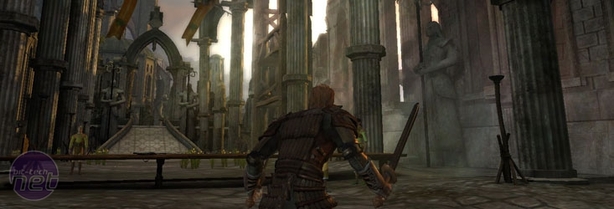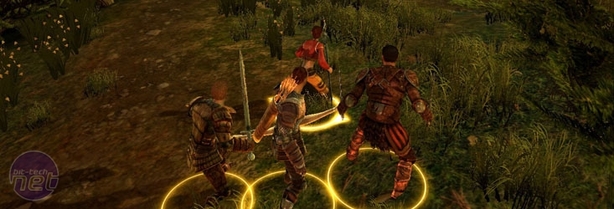Year of the Lizard
Once you get into the meat of the game though everything settles down and becomes much more familiar and conventional than all this ‘origin stories’ nonsense.Instead it slips nicely into the usual framework of a BioWare RPG; a small party of conversational characters lead by the player, possible romances and plentiful side-quests that give you a chance to openly examine how good or evil you are. Lovely stuff.
A long time has passed since the last game in the Baldur’s Gate series came out though and BioWare has been careful to use that time to learn from its mistakes, enabling it to make a game which is in a similar style...but a little bit different.
The major and most obvious difference then is that the Dragon Age: Origins appears entirely in 3D, unlike the last PC exclusive BioWare made which was fixed-camera isometric. Dragon Age can still be played from that high, mouse-driven and isometric camera point, but like The Witcher the view can also be switched to an over-the-shoulder camera.
Speaking of the platform exclusivity, it’s also worth mentioning that Dragon Age probably isn’t going to stay just on the PC. A PlayStation 3 and Xbox 360 version is planned and, thanks to a recent delay, all three versions should be available at the same time - Q3 2009. Originally Dragon Age was supposed to launch on PC first, with console ports following later. That plan is no longer in motion though, which is a shame.
However you decide to play the game though, the bulk of your main quest in Dragon Age comes from trying to raise an army with which to push back The Blight. To do so you’ll need to prove your worth and win the allegiance of certain groups, be they werewolves, elves or human or any other race. Choosing who to side with is more than just a case of balancing numbers though – some groups aren’t compatible at all or are mutually exclusive.
On a smaller scale the same is true with your party too and, as in Baldur’s Gate where you had to make a choice between Minsc and Edwin, you’ll have to make similar choices in Dragon Age with who you want in your party. Your characters are as vocal as always too, giving you options to develop them over time in terms of both abilities and personality.
Character development isn’t entirely a matter of recruitment and then repeated talking-tos though and Dragon Age doesn’t use the simple Dungeons and Dragons alignment system to tag incompatible characters either, as Baldur’s Gate did. Instead, characters have visible attitude meters which indicate how happy they are with your leadership. If a character gets too unhappy with how you’re running the show then they might choose to leave – or even deal with you violently.
How much a character’s attitude is altered depends not just on the action itself, but also on the character. Even though it isn’t quantified by an alignment system there are still good and evil characters to choose from.
Evil is perhaps the wrong word though as the quest in Dragon Age is still linear and essentially good – as with Mass Effect you always end up doing The Right Thing, but can do it in bad ways. The plot is more elastic than it is free-roaming, so evil characters are better described as antisocial or selfish rather than truly bad.

MSI MPG Velox 100R Chassis Review
October 14 2021 | 15:04












Want to comment? Please log in.